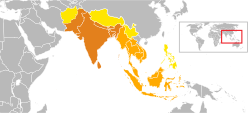
Back الهند الكبرى Arabic India Agung BAN Huria India BBC Вялікая Індыя Byelorussian Голяма Индия Bulgarian ग्रेटर इंडिया Bihari বৃহত্তর ভারত Bengali/Bangla Hindıstano Gırd DIQ Granda Hindio Esperanto Mundo indio Spanish
Greater India, also known as the Indian cultural sphere, or the Indic world, is an area composed of many countries and regions in South, East Asia and Southeast Asia that were historically influenced by Indian culture, which itself formed from the various distinct indigenous cultures of these regions.[4] The term Greater India, as a reference to the Indian cultural sphere, was popularised by a network of Bengali scholars in the 1920s. It is an umbrella term encompassing the Indian subcontinent and surrounding countries, which are culturally linked through a diverse cultural cline. These countries have been transformed to varying degrees by the acceptance and introduction of cultural and institutional elements from each other. Since around 500 BCE, Asia's expanding land and maritime trade had resulted in prolonged socio-economic and cultural stimulation and diffusion of Buddhist and Hindu beliefs into the region's cosmology, in particular in Southeast Asia and Sri Lanka.[5] In Central Asia, the transmission of ideas was predominantly of a religious nature.
By the early centuries of the common era, most of the principalities of Southeast Asia had effectively absorbed defining aspects of Indian culture, religion, and administration. The notion of divine god-kingship was introduced by the concept of Harihara, and Sanskrit and other Indian epigraphic systems were declared official, like those of the south Indian Pallava dynasty and Chalukya dynasty.[6][7] These Indianized kingdoms, a term coined by George Cœdès in his work Histoire ancienne des états hindouisés d'Extrême-Orient,[8] were characterized by resilience, political integrity, and administrative stability.[9]
To the north, Indian religious ideas were assimilated into the cosmology of Himalayan peoples, most profoundly in Tibet and Bhutan, and merged with indigenous traditions. Buddhist monasticism extended into Afghanistan, Uzbekistan, and other parts of Central Asia, and Buddhist texts and ideas were accepted in China and Japan in the east.[10] To the west, Indian culture converged with Greater Persia via the Hindu Kush and the Pamir Mountains.[11]
- ^ Patel, Sneha (2015). "India's South Asian Policy". The Indian Journal of Political Science. 76 (3): 677–680. JSTOR 26534911.
It is important to note that Nepal was not a British colony like India. Geographically, culturally, socially and historically India and Nepal are linked most intimately and lived together from time immemorial. The most significant factor which has nurtured Indo-Nepalese relations through ages is geographical setting of the two countries which is a good example to understand that how geography connects the two countries.
- ^ Mehta, Jaswant Lal (1979). Advanced Study in the History of Medieval India. Vol. I (1st ed.). Sterling Publishers. p. 31. OCLC 557595150.
Modern Afghanistan was part of ancient India; the Afghans belonged to the pale of Indo-Aryan civilisation. In the eighty century, the country was known by two regional names—Kabul land Zabul. The northern part, called Kabul (or Kabulistan) was governed by a Buddhist dynasty. Its capital and the river on the banks of which it was situated, also bore the same name. Lalliya, a Brahmin minister of the last Buddhist ruler Lagaturman, deposed his master and laid the foundation of the Hindushahi dynasty in c. 865.
- ^ Chandra, Satish (2006). Medieval India: From Sultanat to the Mughals. Har-Anand Publications. p. 41. ISBN 9788124110669.
Although Afghanistan was considered an integral part of India in antiquity, and was often called "Little India" even in medieval times, politically it had not been a part of India after the downfall of the Kushan empire, followed by the defeat of the Hindu Shahis by Mahmud Ghazni.
- ^ Lévi, Sylvain; Przyluski, Jean; Bloch, Jules (1993). Pre-Aryan and Pre-Dravidian in India. Asian Educational Services. ISBN 978-81-206-0772-9. Archived from the original on 26 March 2023. Retrieved 26 March 2023.
- ^ Kenneth R. Hal (1985). Maritime Trade and State Development in Early Southeast Asia. University of Hawaii Press. p. 63. ISBN 978-0-8248-0843-3. Archived from the original on 26 March 2023. Retrieved 26 March 2023.
- ^ Lavy, Paul (2003), "As in Heaven, So on Earth: The Politics of Visnu Siva and Harihara Images in Preangkorian Khmer Civilisation", Journal of Southeast Asian Studies, 34 (1): 21–39, doi:10.1017/S002246340300002X, S2CID 154819912, archived from the original on 12 August 2021, retrieved 23 December 2015
- ^ Cite error: The named reference
Stark1999was invoked but never defined (see the help page). - ^ Coedès (1968), pp. 14–.
- ^ Manguin, Pierre-Yves (2002), "From Funan to Sriwijaya: Cultural continuities and discontinuities in the Early Historical maritime states of Southeast Asia", 25 tahun kerjasama Pusat Penelitian Arkeologi dan Ecole française d'Extrême-Orient, Jakarta: Pusat Penelitian Arkeologi / EFEO, pp. 59–82, archived from the original on 26 March 2023, retrieved 26 March 2023
- ^ "Buddhism in China: A Historical Overview" (PDF). The Saylor Foundation 1. Archived (PDF) from the original on 3 March 2016. Retrieved 12 February 2017.
- ^ Zhu, Qingzhi (March 1995). "Some Linguistic Evidence for Early Cultural Exchange between China and India" (PDF). Sino-Platonic Papers. 66. University of Pennsylvania. Archived (PDF) from the original on 4 August 2019. Retrieved 26 March 2023.
everyone knows well the so-called "Buddhist conquest of China" or "Indianized China"
© MMXXIII Rich X Search. We shall prevail. All rights reserved. Rich X Search
